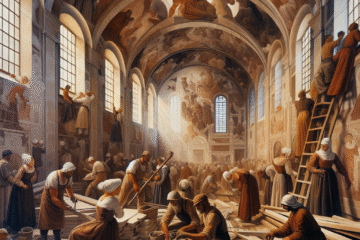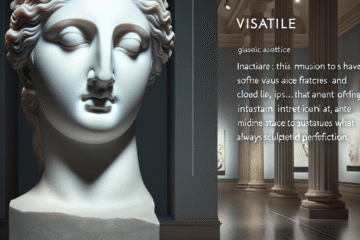I. Introduction
Gustav Klimt’s ‘The Kiss’ is one of the most iconic paintings of the early 20th century. The painting, which was completed in 1908, features a couple locked in a passionate embrace, surrounded by a field of shimmering gold. Klimt’s use of vivid colors, intricate patterns, and symbolism make this painting a masterpiece of the Art Nouveau movement.
Gustav Klimt was an Austrian painter and one of the most prominent members of the Vienna Secession movement. He was known for his sensual and erotic paintings, as well as his use of gold leaf in his artwork. Klimt was inspired by a wide range of art movements, including Byzantine art, Art Nouveau, and Symbolism.
The purpose of this article is to explore the symbolism in ‘The Kiss’ and its significance in Klimt’s career. By examining the various symbols present in the painting, we can gain a deeper understanding of Klimt’s artistic style and the historical and cultural context in which the painting was created. Furthermore, this article will analyze the impact of ‘The Kiss’ on the art world and its significance as a masterpiece of the Art Nouveau movement.
Overall, ‘The Kiss’ is a painting that continues to captivate audiences over a century after its creation. Its enduring popularity is a testament to Klimt’s artistic genius and his ability to capture the complex emotions of love and desire in a single work of art. In the following sections, we will delve deeper into the symbolism and significance of this iconic painting.
II. Overview of ‘The Kiss’
Gustav Klimt’s ‘The Kiss’ is a stunning example of Art Nouveau painting that has captured the hearts and imaginations of art lovers for over a century. The painting, which measures 180 x 180 cm, was created using oil paints and gold leaf on canvas, and depicts a couple locked in a passionate embrace. The man and woman are standing in a field of flowers, surrounded by swirling patterns of gold that seem to radiate from their bodies.
Klimt completed ‘The Kiss’ in 1908, at a time when he was at the height of his artistic career. He was commissioned to create the painting by the Austrian government for the Kunsthistorisches Museum in Vienna. The painting was meant to be a celebration of the Arts and Crafts movement, which was gaining popularity at the time.
Klimt’s use of gold leaf in ‘The Kiss’ is one of the painting’s most striking features. The gold leaf adds a sense of opulence and luxury to the painting, and serves as a symbol of the couple’s love and passion. The intricate patterns and shapes that surround the figures add to the painting’s overall sense of movement and energy, as if the couple is caught in a swirling vortex of desire.
The figures themselves are stylized and abstracted, with elongated limbs and flattened forms that are reminiscent of Byzantine art. The woman’s flowing dress, decorated with floral patterns and geometric shapes, adds to the sense of movement and vitality in the painting. The man’s clothing, by contrast, is plain and unadorned, emphasizing the woman’s beauty and the intensity of their connection.
Overall, ‘The Kiss’ is a masterpiece of Art Nouveau painting that continues to captivate audiences with its beauty and sensuality. Klimt’s use of gold leaf, intricate patterns, and abstract forms all come together to create a painting that is both elegant and passionate. Its enduring popularity is a testament to Klimt’s skill as an artist and his ability to capture the complexities of human emotion in his work.
III. Symbolism in ‘The Kiss’
Gustav Klimt’s ‘The Kiss’ is a masterpiece of Art Nouveau painting that is filled with intricate symbols and hidden meanings. In this section, we will explore the various symbols present in the painting, including the use of gold leaf, patterns, and shapes, as well as the symbolism of the figures themselves.
One of the most prominent symbols in ‘The Kiss’ is the use of gold leaf. Klimt was known for his use of gold in his artwork, and in ‘The Kiss’ he employs gold leaf to add a sense of opulence and luxury to the painting. The gold also serves as a symbol of the couple’s love and passion, as if their bodies are radiating a golden aura. The use of gold leaf also has spiritual connotations, as it is often associated with the divine and the sacred.
The intricate patterns and shapes that surround the figures in ‘The Kiss’ are also significant symbols in the painting. These patterns are reminiscent of the Art Nouveau style, which was characterized by its use of organic forms and flowing lines. The patterns also add to the sense of movement and energy in the painting, as if the figures are caught in a swirling vortex of desire.
The figures themselves are stylized and abstracted, with elongated limbs and flattened forms. The woman’s flowing dress, decorated with floral patterns and geometric shapes, adds to the sense of movement and vitality in the painting. The man’s clothing, by contrast, is plain and unadorned, emphasizing the woman’s beauty and the intensity of their connection.
The posture and facial expressions of the figures are also significant symbols in the painting. The man’s embrace of the woman is tender and protective, while the woman’s posture is relaxed and trusting. The couple’s facial expressions are also noteworthy, with the man’s closed eyes suggesting a sense of surrender and the woman’s open eyes conveying a sense of vulnerability and openness.
The use of color in ‘The Kiss’ is also significant. The dominant color in the painting is gold, which symbolizes the couple’s love and passion. The flowers in the field surrounding the figures are primarily shades of blue and purple, which are often associated with royalty and spirituality. The woman’s dress is primarily white, which symbolizes purity and innocence.
Overall, ‘The Kiss’ is a painting filled with complex symbols and hidden meanings. Klimt’s use of gold leaf, patterns, shapes, posture, facial expressions, and color all come together to create a painting that is both elegant and passionate. Its enduring popularity is a testament to Klimt’s skill as an artist and his ability to capture the complexities of human emotion in his work.
IV. Significance of ‘The Kiss’
Gustav Klimt’s ‘The Kiss’ is a painting that has had a significant impact on the art world and on Klimt’s career as an artist. In this section, we will explore the historical and cultural context in which the painting was created, the impact of the painting on the art world, and the various interpretations of its meaning.
‘The Kiss’ was created in 1908, at a time when Vienna was undergoing significant cultural and political changes. The city was a center of artistic and intellectual activity, with a vibrant avant-garde community that included Klimt and other artists associated with the Vienna Secession movement. This movement was characterized by its rejection of traditional artistic conventions and its embrace of new forms of expression, such as Art Nouveau.
Klimt’s use of gold leaf and intricate patterns in ‘The Kiss’ was emblematic of the Art Nouveau style, which was characterized by its use of organic forms and flowing lines. However, the painting was also influenced by Klimt’s interest in Byzantine art, which is evident in the stylized and abstracted forms of the figures.
‘The Kiss’ was a critical and commercial success, and it cemented Klimt’s reputation as one of the leading artists of his time. The painting was exhibited in a number of prestigious venues and was widely reproduced, both as a print and in other forms such as ceramics and jewelry. Its popularity was due in part to its sensual and erotic subject matter, which was unusual for a painting of its time.
The impact of ‘The Kiss’ on the art world has been significant. The painting has inspired countless imitations and adaptations, and it continues to be a popular subject for contemporary artists. Its influence can be seen in a wide range of art movements, including Art Deco and Surrealism.
The meaning of ‘The Kiss’ has been the subject of much debate and interpretation. Some have seen the painting as a celebration of romantic love, while others have interpreted it as a representation of spiritual or divine love. Some have seen the gold leaf as a symbol of materialism and excess, while others have seen it as a symbol of purity and transcendence.
Overall, ‘The Kiss’ is a painting that has had a significant impact on the art world and on Klimt’s career. Its enduring popularity is a testament to its beauty and its ability to capture the complexities of human emotion in a single work of art. Whether seen as a celebration of love, a representation of spiritual longing, or a commentary on materialism, ‘The Kiss’ remains a powerful and evocative painting that continues to captivate audiences over a century after its creation.
V. Conclusion
In conclusion, Gustav Klimt’s ‘The Kiss’ is a masterpiece of Art Nouveau painting that has captivated audiences for over a century. This article has explored the various symbols present in the painting, including the use of gold leaf, patterns, shapes, posture, facial expressions, and color. We have also examined the historical and cultural context in which the painting was created, as well as the impact of the painting on the art world and its significance in Klimt’s career.
‘The Kiss’ is a painting that continues to inspire and provoke debate among art lovers and scholars. Its symbolism and hidden meanings have been the subject of much interpretation and analysis, with some seeing it as a celebration of romantic love, and others as a representation of spiritual or divine love. The use of gold leaf in the painting is particularly significant, adding a sense of opulence and luxury while also symbolizing the couple’s love and passion.
Overall, ‘The Kiss’ is a painting that remains as relevant and powerful today as it was over a century ago. Its enduring popularity is a testament to Klimt’s skill as an artist and his ability to capture the complexities of human emotion in his work.
As we continue to explore the meaning and symbolism of ‘The Kiss’, we are reminded of the power of art to inspire and provoke us. This painting challenges us to consider the many ways in which love, desire, and spirituality intersect, and to consider the role of beauty and aesthetics in our lives. It is a painting that invites us to reflect on our own experiences of love and passion, and to consider the ways in which we express these emotions in our own lives.
In conclusion, ‘The Kiss’ is a painting that invites us to explore the many complexities of the human experience, and to consider the ways in which art can help us to better understand ourselves and the world around us. As we continue to study and appreciate this remarkable work of art, we are reminded of the enduring power of creativity and imagination to move us and inspire us to new heights of understanding and appreciation.


